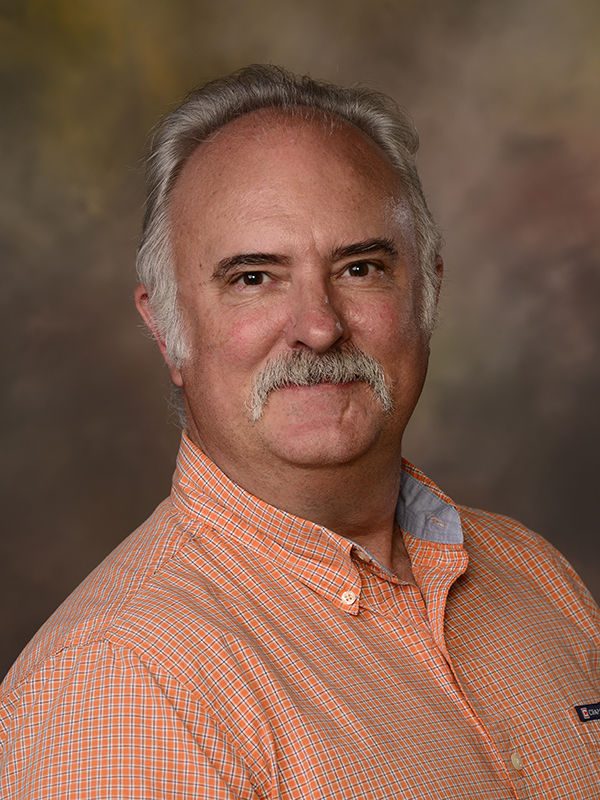
Willis Hames
Department of Geosciences
Professor
Department of Geosciences
Professor
Research Areas: Geochronology and Petrology. Active research interests include measurement of geologic age with advanced 40Ar/39Ar techniques and evaluating the pressure-temperature-time evolution of earth materials.
Office: 2119 Beard Eaves Coliseum
Lab: 2118 Beard Eaves Coliseum
Address:
2050 Beard Eaves Coliseum
Auburn, AL 36849
Phone: (334) 844-4881
Fax: (334) 844-4295
Email: hameswe@auburn.edu
Education
Ph.D., Geology, Virginia Tech
1990
M.S., Geology, University of Georgia
1988
B.S., Geology, University of Georgia
1983
Professional Employment
Professor, Auburn University
2006 - Present
Associate Professor, Auburn University
1999 - 2006
Assistant Professor, Auburn University
1994 - 1999
Research Associate, Massachusetts Institute of Technology
1990 - 1994
Research and Teaching Interests
Dr. Hames teaches undergraduate courses in Physical Geology, Mineralogy, and Petrology, as well as advanced undergraduate and graduate courses in Metamorphic Petrology and Geochronology. Dr. Hames uses an integrated approach to geologic work that combines several tools of study (field mapping, petrography, the electron microprobe, fluid inclusion techniques, geochronology, and numerical modeling) that allow him to bring a variety of research experiences into classroom instruction and to design projects that match the interests of individual students. A principal interest of Dr. Hames is the interpretation of Earth's tectonic history as recorded in igneous and metamorphic rocks and minerals. The general approach to this work is first to study the regional tectonic history of terrains through field mapping and petrology, and then to proceed with more detailed research into the processes that form or change the chemical and isotopic composition of minerals. For example, Dr. Hames' work in the Appalachians and Caledonides utilizes field relationships and petrology to study the conditions and relationships of the major mountain-building events. Dr. Hames works to enhance the techniques for this type of research by, for example, investigating the processes that can form and modify garnet composition (commonly used as a basis for temperature and pressure estimates), and by developing new methods and applications for isotopic dating. Such work has been supported by NSF funding to Dr. Hames and his colleagues, including Dr. Mark Steltenpohl of Auburn University and Dr. Robert Tracy of Virginia Tech. Much of the current research by Dr. Hames and his students focuses on the evolution of the Early Jurassic 'Central Atlantic Magmatic Province' or CAMP. Graduate students Daniel Morris and William Branton of Auburn University are studying the petrology of basalt dikes in the southeastern USA and buried flows of the South Georgia Rift basin in an effort to characterize the mechanisms of early Pangean rifting and generation of this large igneous province. This NSF-sponsored research is in collaboration with Dr. Carolyn Ruppel of Virginia Tech, with scientists at Florida State University (Dr. Vincent Salters and Dr. Paul Ragland) and the University of California at Berkeley (Dr. Paul Renne). Dr. Hames has worked extensively to enhance and extend the applications of 40Ar/39Ar dating. Technical innovations in mass spectrometry and 40Ar/39Ar analysis over the past decade, such as micro-sampling with a laser, allow us to address new and increasingly detailed questions about Earth's history. Much of Dr. Hames' initial work with laser 40Ar/39Ar techniques dealt with laser dating of muscovite from complexly metamorphosed or slowly cooled plutonic rocks. This work has mainly been pursued with colleagues at MIT (Dr. Kip Hodges and Sam Bowring), the Open University (Dr. Simon Kelley), and Amherst College (Dr. Jack Cheney). Recently, Dr. Hames geochronologic studies have greatly expanded in scope, and he is currently working to date meteorite impact events (through projects with Dr. David King of Auburn University and Dr. Peter Schultz of Brown University), hominid evolution in Indonesia (with Dr. Andy Kramer of the University of Tennessee, Knoxville), and global climate change in the Carboniferous (with Dr. Hermann Pfefferkorn of the University of Pennsylvania). This is an exciting time for geochronologic research, as new technical advances facilitate research collaborations and pose new research questions. Dr. Hames is currently building an automated laser 40Ar/39Ar microanalytical facility at Auburn University, with funding provided by Auburn University. The new geochronologic facility is scheduled to be commissioned in the fall of 2001.
Selected Publications
- Hames, W.E., Renne, P.R., and Ruppel, C., 2000, New evidence for geologically-instantaneous emplacement of earliest Jurassic Central Atlantic magmatic province basalts on the North American margin. Geology, v. 28, no. 9, p. 859-862.
- Klein, A.C., Steltenpohl, M.G., Hames, W.E., and Andresen, A., 1999, Ductile and brittle extension in the Lofoten archipelago, north Norway: implications for differences in tectonic style along an ancient collisional orogen. American Journal of Science, v. 299, p. 69-89.
- Schultz, P.H., Zarate, W. Hames, M., Camilion, C., and King, J., 1998, A 3.3-Ma Impact in Argentina and Possible Consequences. Science, v. 282, p. 2061-2063.
- Hames, W.E., and Cheney, J.T., 1997, On the retention of 40Ar* in polymetamorphic muscovite. Geochimica et Cosmochimica Acta, v. 61, no. 18, p. 3863-3872.
- Hames, W.E., and Andresen, A., 1996, The timing of late Paleozoic extension between Norway and Greenland as indicated by laser 40Ar/39Ar muscovite dating. Geology, v. 24, p. 1005-1008.
Last updated: 01/25/2023
